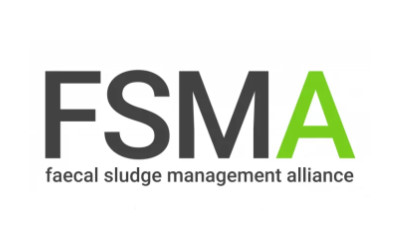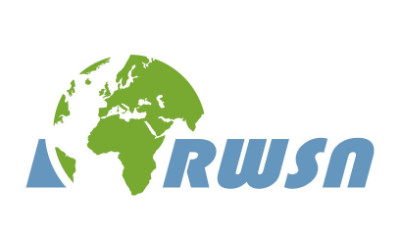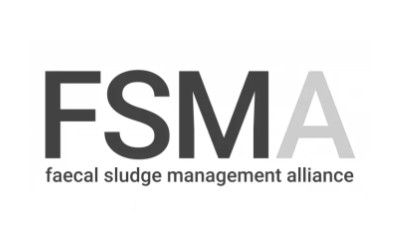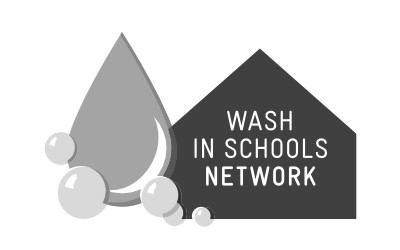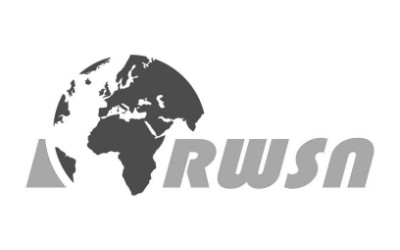Identificación y cuantificación automática de huevos de helmintos en muestras de agua residual (in Spanish) - Automatic identification and quantification of helminth eggs in wastewater samples
Pérez Sánchez, J. D. (2013)
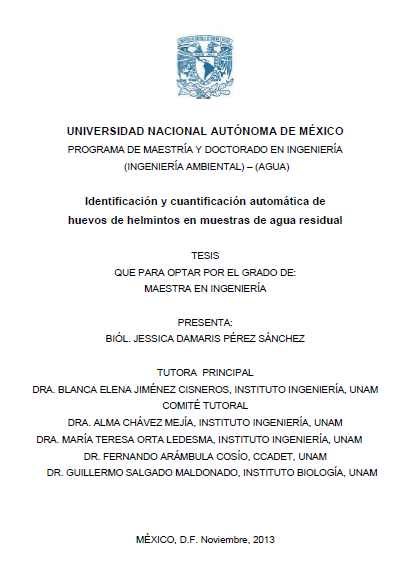
Published in: 2013
Publisher:
MSc thesis, Universidad Nacional Autónoma de México (UNAM), Mexico
Author:
Pérez Sánchez, J. D.
Uploaded by:
SuSanA secretariat
Partner profile:
common upload
5286 Views
139 Downloads
Content - Summary
Summary in English (in Spanish further down below):
Nowadays, the treatment applied to residual water can greatly reduce the concentration of pathogens, but it is still difficult to ensure complete removal, so the water is the vehicle for transmission of pathogenic organisms such as the helminths. Helminths are parasitic worms that infect communities with low levels of sanitation, causing intestinal diseases, hence the importance of identifying and quantifying them as accurately as possible.
Since the conventional method of identifying these organisms depends on the ability of humans to recognize them, is always needed the assistance of an expert in such identification, because it requires a very good training and a continual practice on analysis.
Considering this, we propose a new methodology based on image processing and classification for automatic identification and quantification of helminth eggs through optical microscope captured images, which aims to simplify the established analytical technique, reduce costs and analysis time. This thesis focused on the development of software for identifying and quantifying automatically helminth eggs images of different species, in order to develop a system for environmental control laboratories and research, not also at national level, it goes internationally.
Given the complexity of biological automatic image analysis, we performed a comparative study of protocols for image processing techniques applicable for this study. The development of automatic identification technique used 360 images of different species (Ascaris lumbricoides (fertile and infertile), Hymenolepis nana, H. diminuta, Schistosoma mansoni, Taenia sp., Toxocara canis and Trichuris trichiura), which allowed train system and establish a range of values for each property classification.
System validation is always performed with residual water samples, we commonly used three different qualities based on the total suspended solids (TSS). Class I was called to water 150 mg / L (TSS), where quality is typical of an untreated wastewater. This allowed us to validate the results according to the amount of solids present in water. For Class I and Class II, results were obtained identifying specificity 0.99 and 0.98, respectively, indicating that the system is able to distinguish between significant accuracy helminth egg and different objects. For the same quality of water, yielded a sensitivity of 0.83 and 0.80, respectively, indicating that the system's ability to identify a species among other exceeds 80%. The Class III identification efficiency was considerably lower (15%) than samples I or II. So in the current conditions of the system, must be carried out a prior dilution of the samples before identification and quantification through software.
The advantages of the developed system versus the traditional technique are: a) No specific skills required for the recognition of the species. b) Samples with different amount of total suspended solids can be identified in approximately 10 minutes against three hours or more of the traditional technique. c) The initial cost of the software is 30,000 compared to 20,000 dls of the traditional technique, but the operating cost per sample is less in the case of software with 2 dlls per sample versus 10 - 35 dlls for traditional technique. Regarding the specificity and sensitivity of the developed software, both features exceed 80%, while the traditional technique depends on previously acquired human skills.
++++++++++++++
RESUMEN (in Spanish)
En la actualidad el tratamiento aplicado al agua residual puede reducir en mucho las concentraciones de organismos patógenos; sin embargo, aún es muy difícil asegurar su completa eliminación, por lo que este tipo de agua se convierte en un vehículo de transmisión de organismos patógenos, como son los helmintos. Los helmintos son gusanos parásitos que en su estadio de huevo infectan a comunidades con bajo nivel de saneamiento, causando enfermedades intestinales, por ello la importancia de identificarlos y cuantificarlos con la mayor precisión posible. Dado que el método convencional de identificación de estos organismos depende de la capacidad del ser humano para reconocerlos, es necesaria siempre la intervención de personal experto en dicha identificación, pues al llevarse a cabo de manera visual, representa la principal fuente de incertidumbre y requiere de un muy buen entrenamiento y práctica continua por parte del analista. Considerando esto se propone una nueva metodología basada en el procesamiento y clasificación de imágenes para la identificación y cuantificación automática de huevos de helmintos a través de imágenes capturadas en microscopio óptico, con lo cual se busca simplificar la técnica analítica establecida y reducir los costos y el tiempo del análisis. Esta tesis se centró en el desarrollo de un software para identificar y cuantificar de manera automática imágenes de huevos de helmintos de diferentes especies, con la finalidad de que se pueda desarrollar en un futuro un sistema para laboratorios de control ambiental y de investigación no sólo a nivel nacional sino que pueda ser distribuido internacionalmente.
Dada la complejidad del análisis automático de imágenes biológicas, se realizó un estudio comparativo de los protocolos de reconocimiento disponibles así como de las técnicas de procesamiento de imágenes aplicables a este estudio. Para el desarrollo de la técnica de identificación automática se emplearon 360 imágenes de especies (Ascaris lumbricoides (fértil e infértil), Hymenolepis nana, H. diminuta, Schistosoma mansoni, Taenia sp., Toxocara canis y Trichuris trichiura), las cuales permitieron entrenar al sistema y establecer un intervalo de valores para cada propiedad de clasificación. La validación del sistema siempre se llevó a cabo con muestras de agua residual y se utilizaron comúnmente tres calidades diferentes con base al contenido de sólidos suspendidos totales (SST). La clase I se denominó para agua con 150 mg/L SST, donde la calidad es la propia de una agua residual sin tratamiento; esto permitió validar los resultados según la cantidad de sólidos presentes.
Para el agua clase I y clase II, se obtuvieron resultados de especificidad de la identificación de 0.99 y 0.98, respectivamente, lo que indica que el sistema es capaz de distinguir con significativa exactitud entre un huevo de helminto y objetos diferentes. Para esas mismas calidades de agua, se obtuvo una sensibilidad de 0.83 y 0.80, respectivamente, lo que indica que la capacidad del sistema para identificar una especie entre las demás supera el 80%. Para el caso del agua clase III, la eficacia de identificación fue considerablemente menor (15%) que para las muestras de clase I o II. Así que en las condiciones actuales del sistema y para el caso de muestras de aguas residuales con alto contenido de sólidos, se debe llevar a cabo, una dilución previa de las muestras antes de su identificación y cuantificación a través del software.
Las ventajas del sistema desarrollado frente a la técnica tradicional son: a) No se requieren habilidades específicas del personal para el reconocimiento de las especies. b) Muestras con diversa cantidad de sólidos suspendidos totales pueden ser identificadas en aproximadamente 10 minutos contra tres horas o más de la técnica tradicional. c) El costo inicial del software es de 30,000 dls frente a 20,000 dls de la técnica tradicional, pero el costo operativo por muestra es menor en el caso del software, con 2 dls por muestra contra un mínimo de 10 dls y máximo 35 dls de la técnica tradicional. En cuanto a la especificidad y sensibilidad del software desarrollado, ambas características superan el 80%, mientras que la técnica tradicional depende de las habilidades humanas previamente adquiridas.
Bibliographic information
Pérez Sánchez, J. D. (2013). Identificación y cuantificación automática de huevos de helmintos en muestras de agua residual (in Spanish) - Automatic identification and quantification of helminth eggs in wastewater samples. MSc thesis, Universidad Nacional Autónoma de México (UNAM), Mexico
Filter tags
Latin America & Caribbean Spanish







